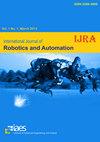微处理器控制假膝作动器和阻尼器的研究现状
IF 1
4区 计算机科学
Q4 AUTOMATION & CONTROL SYSTEMS
International Journal of Robotics & Automation
Pub Date : 2019-04-01
DOI:10.15406/iratj.2019.05.00172
引用次数: 0
摘要
根据第二次全国残疾人抽样调查数据计算,中国残疾人总数为8296万人,其中肢体残疾2412万人,截肢者226万人下肢截肢者的数量约为158万人下肢截肢者为适应日常生活活动,需要安装下肢义肢。对于经股(膝上)肢体丧失的患者,下肢假体至少包括关节窝、膝关节、足以及连接这些部件所需的桥架或适配器在其发展中付出最大努力的部分是膝关节假体。膝盖在整个步态周期中起着关键作用,这基本上是由于膝关节设置了由两个身体组成的腿,通过它相互连接。这是人体大腿和小腿之间的情况,从这种腿部结构中可以理解为自然步态。此外,撇开脚的阻尼和脉冲功能不提,这最后一个特征使人的步态成为使人体从一个地方移动到另一个地方的最有效的方式假膝按其控制的复杂性来区分:机械被动、微处理器控制的被动和微处理器控制的主动机械被动控制膝的阻尼不能随速度变化而改变,常表现为步态异常,增加了截肢者行走的能量消耗。微处理器控制的人工膝关节是目前研究的热点。微处理器控制的假膝分类如图1所示。本文章由计算机程序翻译,如有差异,请以英文原文为准。
State of the art of actuator and damper for micro-processor controlled prosthetic knee
According to the data calculation of the second national handicapped person sampling survey, the sum of disabled people in China is 82.96 million, including 24.12 million physical disabilities and 2.26 million amputees.1 The number of lower limb amputee is about 1.58 million.2 To cope with daily life activities, lower limb amputees require to install lower limb prosthesis. Lower limb prosthesis for a person with transfemoral (above-knee) limb loss includes, at a minimum, a socket, knee, foot, and the necessary pylons or adapters to connect these components.3 The part that has taken the biggest efforts in its development is the knee prosthesis. The knee performs a key role during the whole gait cycle, and this is basically due to the fact that the knee joint sets a leg made of two bodies, articulated between each other through it. This is the case in human body between thigh and shank, being this leg configuration from which it is understood a natural gait. Moreover, this last feature, leaving aside damping and impulse functions of feet, is what makes human gait the most efficient mode of moving human body from one place to another.4 The prosthetic knee is separated by the complexity of their control: mechanically passive, microprocessor controlled passive, and microprocessor controlled active.5 Damping of mechanically passive control knee cannot be changed with different speeds and often characterized by abnormal gait, increasing energy expenditure of amputees to walk. Microprocessor-controlled prosthetic knee are the research focus. The classification of microprocessor-controlled prosthetic knee is shown in Figure 1.
求助全文
通过发布文献求助,成功后即可免费获取论文全文。
去求助
来源期刊
CiteScore
1.20
自引率
44.40%
发文量
71
审稿时长
8 months
期刊介绍:
First published in 1986, the International Journal of Robotics and Automation was one of the inaugural publications in the field of robotics. This journal covers contemporary developments in theory, design, and applications focused on all areas of robotics and automation systems, including new methods of machine learning, pattern recognition, biologically inspired evolutionary algorithms, fuzzy and neural networks in robotics and automation systems, computer vision, autonomous robots, human-robot interaction, microrobotics, medical robotics, mobile robots, biomechantronic systems, autonomous design of robotic systems, sensors, communication, and signal processing.

 求助内容:
求助内容: 应助结果提醒方式:
应助结果提醒方式:


